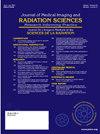A Local Evaluation of 2D/3D Registration of an Orthogonal Pair of Kilo Voltage Images Versus Cone Beam CT for Partial Brain Radiotherapy Patients
IF 2
Q3 RADIOLOGY, NUCLEAR MEDICINE & MEDICAL IMAGING
Journal of Medical Imaging and Radiation Sciences
Pub Date : 2025-05-01
DOI:10.1016/j.jmir.2025.101923
引用次数: 0
Abstract
Purpose/Aim
To evaluate two dimensional (2D/2D) kilo voltage imaging platforms, one two dimensional (2D/3D) registration imaging method and CBCT in the setup reproducibility of the partial brain population in a radiotherapy clinic. This research is for the purpose of potentially replacing CBCT with 2D/3D KV reconstruction for a cohort of partial brain radiotherapy patients.
Methods/Process
The comparison of CBCT, 2D2D and 2D3D with the respective images was performed on a Truebeam linear accelerator. This data was transferred to MOSAIQ which is the internal EMR, (electronic medical record). Shifts were extracted from Mosaiq and manually entered into an excel spreadsheet. Patient sensitive information was anonymized within HIPPA (Health Insurance Portability and accountability act, 1996) compliance. After comparing 2D/2D, 2D/3D and CBCT with their respective reference images, shifts in the lateral, longitudinal and vertical direction were noted on all these 3 comparisons. Additionally, the yaw, pitch and roll were noted in the 2D/3D and CBCT comparisons and the mean and standard deviation calculated. This study analysed 177 data samples for each of the three registration methodologies adding to a total of 531 imaging analysed.
Results or Benefits/Challenges
The Wilcoxon signed- rank test was utilized to compare the 3 registration methods. A P-value <0.05 was considered to be significant. The residual error for the 2D3D in the VRT, LAT and LNG direction is -0.0032 cm ± 0.0456 cm, 0.0131 cm ± 0.0441 cm and 0.0392 cm ± 0.0805 cm while for the 2D2D the residual error is found to be respectively -0.0549 cm ± 0.1828 cm, 0.0935 cm ± 0.254 cm and -0.0165 cm ± 0.2224 cm. The average difference in the RTN for the 2D3D versus CBCT was -0.3008° and for the ROLL was 0.0571°, both < 1°. The difference in the ROLL was not found to be statistically significant (p = 0.5672), while the difference in RTN was statistically significant (p = 0.0439) which can be accounted for in the PITCH.
Conclusions/Impact
Although limited by sample size this data collection indicates that the Varian OBI (on board imaging) system on a Truebeam LINAC offers a 2D3D KV image registration tool that displays accuracy levels for target localization that are similar to 3D3D image registration with CBCT and has the potential to replace CBCT for a selected cohort of a partial brain population.
基电压正交对与锥束CT对局部脑放疗患者二维/三维配准的局部评价
目的:评价二维(2D/2D)千电压成像平台、一维(2D/3D)配准成像方法和CBCT在放射治疗门诊局部脑群设置再现性中的作用。本研究的目的是潜在地用2D/3D KV重建替代CBCT,用于部分脑放疗患者队列。在Truebeam直线加速器上对CBCT、2D2D和2D3D图像进行对比。这些数据被传送到MOSAIQ,即内部电子病历。从马赛克中提取位移并手动输入到excel电子表格中。患者敏感信息在HIPPA(1996年健康保险流通和责任法案)的要求下匿名化。将2D/2D、2D/3D、CBCT与各自的参考图像进行对比后,发现这3种对比在横向、纵向和垂直方向上都发生了变化。此外,在2D/3D和CBCT比较中记录偏航、俯仰和横摇,并计算平均值和标准差。本研究分析了177个数据样本,每种配准方法添加到总共531个成像分析。结果或益处/挑战采用Wilcoxon sign - rank检验比较3种注册方法。p值<;0.05被认为是显著的。2D3D在VRT、LAT和LNG方向的残差分别为-0.0032 cm±0.0456 cm、0.0131 cm±0.0441 cm和0.0392 cm±0.0805 cm, 2D2D方向的残差分别为-0.0549 cm±0.1828 cm、0.0935 cm±0.254 cm和-0.0165 cm±0.2224 cm。2D3D与CBCT的RTN平均差值为-0.3008°,ROLL平均差值为0.0571°。1°。ROLL的差异无统计学意义(p = 0.5672),而RTN的差异有统计学意义(p = 0.0439),这可以在PITCH中解释。结论/影响尽管受样本量的限制,该数据收集表明,Truebeam LINAC上的Varian OBI(机载成像)系统提供了2D3D KV图像配准工具,其目标定位精度水平与3D3D图像配准与CBCT相似,有可能取代CBCT,用于部分大脑人群的选定队列。
本文章由计算机程序翻译,如有差异,请以英文原文为准。
求助全文
约1分钟内获得全文
求助全文
来源期刊

Journal of Medical Imaging and Radiation Sciences
RADIOLOGY, NUCLEAR MEDICINE & MEDICAL IMAGING-
CiteScore
2.30
自引率
11.10%
发文量
231
审稿时长
53 days
期刊介绍:
Journal of Medical Imaging and Radiation Sciences is the official peer-reviewed journal of the Canadian Association of Medical Radiation Technologists. This journal is published four times a year and is circulated to approximately 11,000 medical radiation technologists, libraries and radiology departments throughout Canada, the United States and overseas. The Journal publishes articles on recent research, new technology and techniques, professional practices, technologists viewpoints as well as relevant book reviews.
 求助内容:
求助内容: 应助结果提醒方式:
应助结果提醒方式:


